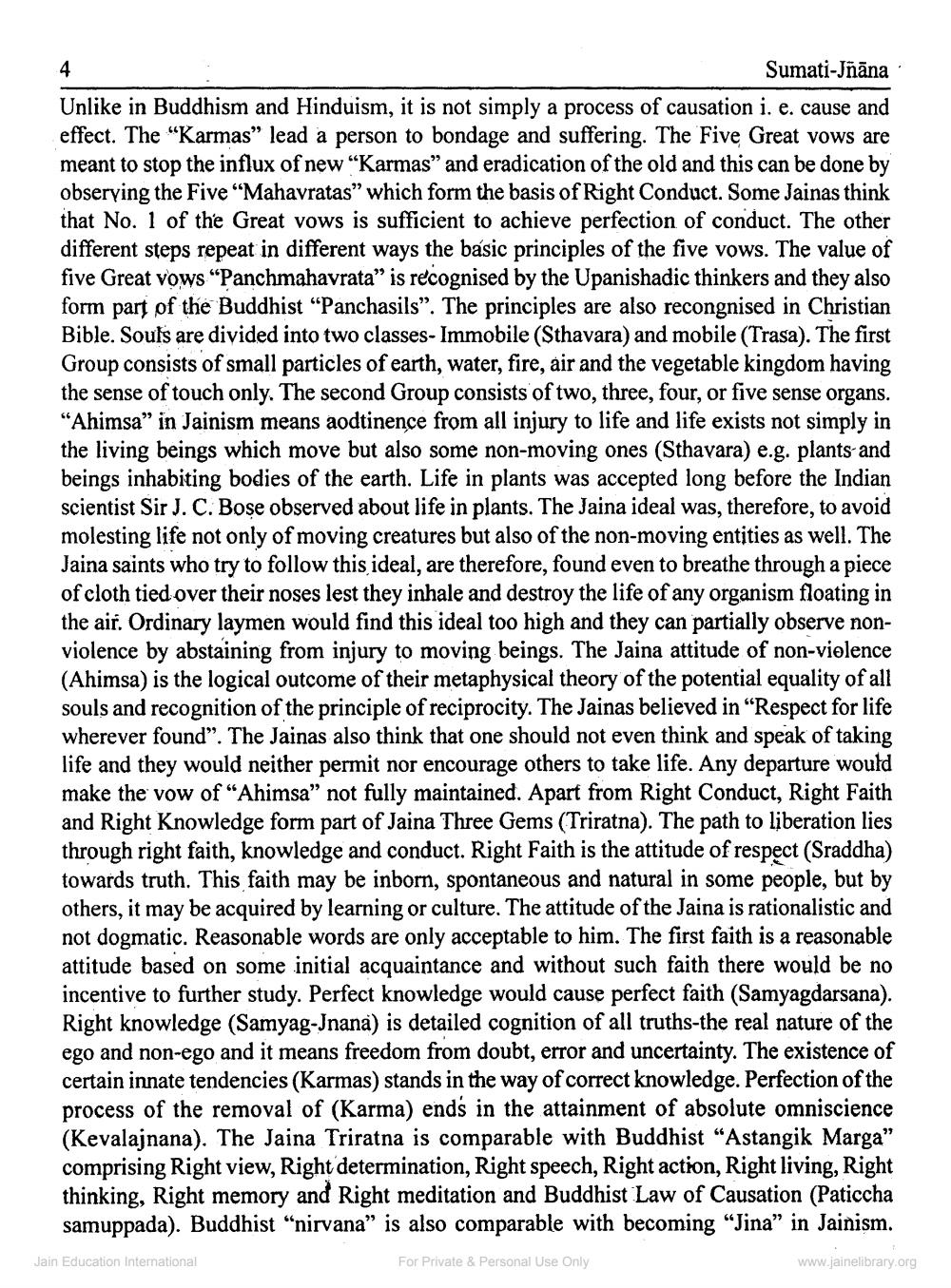________________
Sumati-jñāna Unlike in Buddhism and Hinduism, it is not simply a process of causation i. e. cause and effect. The “Karmas” lead a person to bondage and suffering. The Five Great vows are meant to stop the influx of new "Karmas" and eradication of the old and this can be done by observing the Five “Mahavratas” which form the basis of Right Conduct. Some Jainas think that No. 1 of the Great vows is sufficient to achieve perfection of conduct. The other different steps repeat in different ways the basic principles of the five vows. The value of five Great vows “Panchmahavrata” is recognised by the Upanishadic thinkers and they also form part of the Buddhist "Panchasils". The principles are also recongnised in Christian Bible. Souls are divided into two classes- Immobile (Sthavara) and mobile (Trasa). The first Group consists of small particles of earth, water, fire, air and the vegetable kingdom having the sense of touch only. The second Group consists of two, three, four, or five sense organs. "Ahimsa" in Jainism means aodtinence from all injury to life and life exists not simply in the living beings which move but also some non-moving ones (Sthavara) e.g. plants and beings inhabiting bodies of the earth. Life in plants was accepted long before the Indian scientist Sir J. C. Bose observed about life in plants. The Jaina ideal was, therefore, to avoid molesting life not only of moving creatures but also of the non-moving entities as well. The Jaina saints who try to follow this ideal, are therefore, found even to breathe through a piece of cloth tied over their noses lest they inhale and destroy the life of any organism floating in the air. Ordinary laymen would find this ideal too high and they can partially observe nonviolence by abstaining from injury to moving beings. The Jaina attitude of non-violence (Ahimsa) is the logical outcome of their metaphysical theory of the potential equality of all souls and recognition of the principle of reciprocity. The Jainas believed in "Respect for life wherever found”. The Jainas also think that one should not even think and speak of taking life and they would neither permit nor encourage others to take life. Any departure would make the vow of "Ahimsa" not fully maintained. Apart from Right Conduct, Right Faith and Right Knowledge form part of Jaina Three Gems (Triratna). The path to liberation lies through right faith, knowledge and conduct. Right Faith is the attitude of respect (Sraddha) towards truth. This faith may be inborn, spontaneous and natural in some people, but by others, it may be acquired by learning or culture. The attitude of the Jaina is rationalistic and not dogmatic. Reasonable words are only acceptable to him. The first faith is a reasonable attitude based on some initial acquaintance and without such faith there would be no incentive to further study. Perfect knowledge would cause perfect faith (Samyagdarsana). Right knowledge (Samyag-Jnana) is detailed cognition of all truths-the real nature of the ego and non-ego and it means freedom from doubt, error and uncertainty. The existence of certain innate tendencies (Karmas) stands in the way of correct knowledge. Perfection of the process of the removal of (Karma) ends in the attainment of absolute omniscience (Kevalajnana). The Jaina Triratna is comparable with Buddhist "Astangik Marga" comprising Right view, Right determination, Right speech, Right action, Right living, Right thinking, Right memory and Right meditation and Buddhist Law of Causation (Paticcha
samuppada). Buddhist “nirvana” is also comparable with becoming “Jina" Jain Education International For Private & Personal Use Only
www.jainelibrary.org




